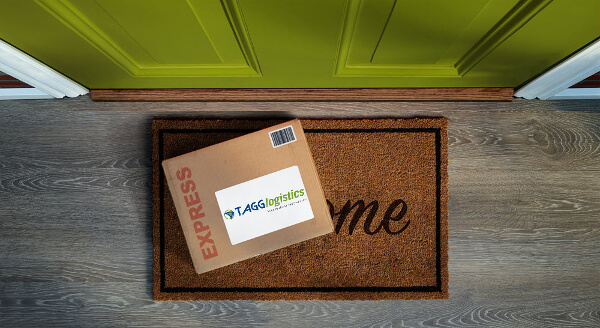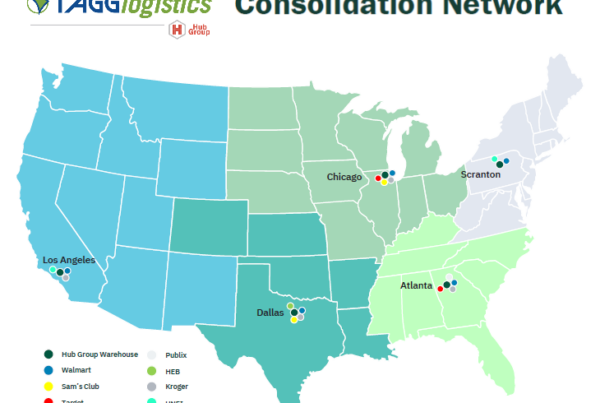Dimensional Weight Pricing on EVERY Shipment Represents a Fundamental Change in the Way Internet Retailers Operate
A New Way to Think
Have you ever received a large box from Amazon with only a few items in it? You probably didn’t think much of it. It is easy to understand why the box size did not match what you purchased. You can order almost anything on Amazon, from toilet paper to watches. Trying to find a box that fits exactly right with infinite order variations would be time consuming and expensive. So the packer, or computer system, evaluates the order and picks the best box, erroring on the side of picking too big a box because you would hate to pack everything out and not be able to fit that last item. Then the packer simply fills the extra space with dunnage. After all, it doesn’t really matter how big the box is, it matters more how much it weighs. It’s the weight that determines shipping price, and air pillows, bubble wrap and peanuts weigh next to nothing.
The e-commerce industry is about to experience quite a jolt, as shipping costs are going to dramatically increase.
This line of thinking is what has guided the e-commerce fulfillment industry from its inception. Weight drives shipping price, and packaging needs to protect product but equally as important, be fast and efficient. The result, pick a box that is larger then necessary, void fill the extra space and get it out the door. Starting January 2015, this fundamental process of e-commerce fulfillment is going to have to change. FedEx and UPS are moving to dimensional pricing for every Ground package. No longer is weight the singular factor of shipping price, box dimension becomes equally as important. Dimensional weight is expected to impact nearly over 30% of all Ground shipments and will be a major driver of change for the industry.
Background of Dimensional Weight
Dimensional weight was put in place to ensure that the carrier is getting paid appropriately for the space the packages take up on its planes or trucks. While FedEx and UPS are introducing a new pricing structure in 2015, the concept of dimensional weight has been around for a while. Since 2007, both have used the tool of volumetric division, where a parcel’s cube is divided by a preset divisor, to price packages based not on their weight, but how much space or ‘cube’ they occupy on a delivery truck. This pricing, based on volume, was used for larger packages only, packages over 3 cubic feet. In 2011, both shrunk that divisor to make it even costlier to ship lightweight, bulky packages. The reasoning is simple, lets say you go to your favorite table tennis website and order 3 cases of ping-pong balls. The internet retailer puts the 3 cases in a large shipping box, puts some air pillow void fill in the box to make them fit snug, and sends them on their way. The box size might be 12 inches x 12 inches x 12 inches, but only weigh 1 pound as Ping-Pong balls are light. So the carrier gets a large box that weighs next to nothing. If the price of that shipment was based solely on weight, it would be very cheap, but it would still take up significant room on the delivery truck. Therefore, the carriers figured out they need to charge for the dimension, or the volume, which the large, lightweight package occupies.
The carriers are aligning the rates they charge with their costs. Delivery expense will be influenced by BOTH the SIZE and WEIGHT of a package.
With e-commerce continuing its rapid growth, the Internet has become a sales channel for items previously reserved for purchase at brick-and-mortar stores. The original dimensional pricing set forth in 2007 was meant to address on-line companies shipping large items like furniture. Today, e-commerce retailers are shipping everything. Amazon and other sites are even pushing the most fundamental of household items through this channel. Towels, diapers even toilet paper. This growth has continued to put pressure on FedEx and UPS to make such shipments profitable, resulting in the new pricing structure.
How it Works
The existing dimensional weight pricing only applies to shipments where the box size exceeds 3 cubic feet. Beginning in 2015, EVERY ground package will be charged based on billable weight, which will be the greater of actual weight or dimensional weight.
Actual Weight is the scaled weight of the package in pounds rounded up to the nearest pound. Lets take a theoretical e-commerce shipment of vitamins and supplements. The package weighs 5.3 lbs. on the scale, and the shipment will be billed based on an actual weight of 6 lbs.
Dimensional Weight is determined by using length x width x height of the box divided by the applicable dimensional factor. Unless a shipper’s agreement calls for a modified dimensional factor, then UPS and FedEx both use 166 for all domestic shipments. Our e-commerce order of vitamins and supplements is packed in a box measuring 12 inches x 10 inches x 10 inches or 1,200 cubic inches. With the old pricing model, anything fewer than 3 cubic feet, or 5,184 cubic inches would not be subject to dimensional weight. So our box, at 1,200 cubic inches would not be affected. Under the new pricing model going into effect, this shipment is subject to dimensional weight.
Back to our box of vitamins and supplements, the cube is then divided by the dimensional factor to get dimensional weight. 1,200 cubic inches divided by 166 equals 7.2. Therefore the dimensional weight would equal 8 lbs.
Billable Weight is the greater of actual weight and dimensional weight. Our order which currently would get billed as a 6 lbs. shipment, because of the size of the box, would get billed as 8 lbs. under the new rule, a 25% increase in billable weight, resulting in a corresponding increase in shipping cost.
Make Adjustments or Pay the Price!
It is difficult to predict the exact impact of this change across all Internet retailers and many will not know until the first billing cycle of 2015. Research varies widely of with predictions anywhere from 30 to 50 percent of all ground shipments being effected. Those e-commerce sites selling smaller, dense items might have a minimal impact. However, websites selling bulky, lighter items and those selling a variety of products with different sizes and weights will no doubt be affected. FedEx and UPS are ready for this with volumetric scanners (that measure and calculate the cube) already in place at their facilities. So like it or not, shippers will simply see any dimensional charges as adjustments on their first bill in 2015. If you are not doing so already, it’s time to start planning, making adjustments and/or getting ready to pay the increased price. Here are the steps we recommend taking:
- What is the impact? It is important to understand the significance of the change as the first step in planning for it. Meet with your fulfillment provider or carrier and have them estimate the impact of dimensional pricing based on your historic shipments. For example, look at all the packages you shipped last month, have your representative calculate a pro forma shipping cost as if the change was in effect. What is the cost difference? Was it a 4% increase or a 14% increase in overall shipping cost? You need to first understand and quantify the effects of the change.
- Intelligent Packaging As previously stated, the use of dimensional weight on all shipments is a fundamental shift in the way ecommerce retailers operate and is here to stay. One of the root causes of the change is poor packaging decisions. At TAGG, we follow procedures we call intelligent packaging, where the size of a box is determined by best fit of the items in the box. Simply picking a larger box and void filling the extra space because that is the fastest approach is no longer cost effective. Plan for more box sizes at the packing station and plan for more time packaging.
Intelligent packaging also involves a greater use of technology. One area of advancement has been box-building technology or carton optimization software. This automation tool uses complex algorithms, which take the dimensions of all the items in an order and then determines the most appropriate box size for that order. Many leading e-commerce and fulfillment companies are utilizing this approach. However, it is an emerging science that has yet to be mastered. Amazon has invested millions in this technology and they simply still struggle to compete with the speed and efficiency of a packer choosing an oversized box and filling it with air pillows.
- Take Care of Check Out Historically in the shopping cart, shipping cost at checkout is often based on the estimated weight of a shipment. Internet retailers need to adjust this methodology to take into consideration the cube of a packed out order. Large shopping carts, like Magento have had various providers emerge to offer extensions or plug-ins to help more accurately determine billable weight and shipping costs. These applications suffer from the same inefficiencies as the carton optimization technologies used on the operations side, but do continue to improve. Fulfillment providers can also work with Internet retailers to develop rules based on ordering patterns and product characteristics that can be loaded into the shopping cart. Metrics, such as product ‘A’, ‘B’, and ‘C’ fit best in box ‘S’ can be established based on experience, when order patterns are repetitive and variety and sizes are limited.
- Capture Dimensions Don’t leave the adjustment up to UPS and FedEx. It will become important to capture both dimensional weight and actual weight during the shipping process in order to accurately determine billable weight. There are a variety of ways to do this, ranging from simple to complex. One of the simplest approaches is to create a series of standardized boxes, with dimensions printed on the box, a scanable barcode with dimensional weight pre-calculated, or preloaded dimensions in your shipping software for each box type (for example, Box A is 12x10x10 = 8lbs., from above). On the more high-tech and complex side, many volume shippers and fulfillment companies are moving to in-line dimensional scanners. These devices are similar to those being used by the carriers to electronically capture the dimensions of the packages. This is an effective approach when an infinite number of items and combinations do not allow for standardized box sizes, or higher volumes dictate a higher speed approach.
- Modify Your Carrier Contract Remember the dimensional factor from above? A divisor of 166 is used by both FedEx and UPS when dividing the cubic inches to get to dimensional weight. Volume shippers and most large fulfillment providers have the ability to negotiate a higher dimensional factor. This will greatly reduce the number of packages in which the dimensional weight exceeds shipping weight, thus reducing packages subject to dimensional charges.
- Choose Shipping Methods Wisely The impact of the change mostly affects UPS and FedEx ground shipments. There are many shipping options that will not be effected by dimensional weights and offer excellent alternatives. The USPS has a variety of products with actual weight-based only pricing or flat fee shipping. Some hybrid methods, which combine the USPS’s infrastructure with that of FedEx or UPS, are not subject to dimensional weight. For example, FedEx SmartPost in which FedEx delivers packages to the destination post office and the USPS takes it to the door will not be affected by the 2015 change. Finally, these dimensional weight changes are predicted to have a positive impact on many regional carriers, which don’t use dimensional weight and are growing in popularity as an alternative to UPS and FedEx.
The days of stuffing a box full of air pillows and peanuts are over. Starting in January, size really does matter. Internet retailers will go through a fundamental shift in the way they package and ship their goods and charge their customers for those shipments. Now is the time to start thinking through the impacts and the operational changes that need to take place. UPS and FedEx are ready, are you?




